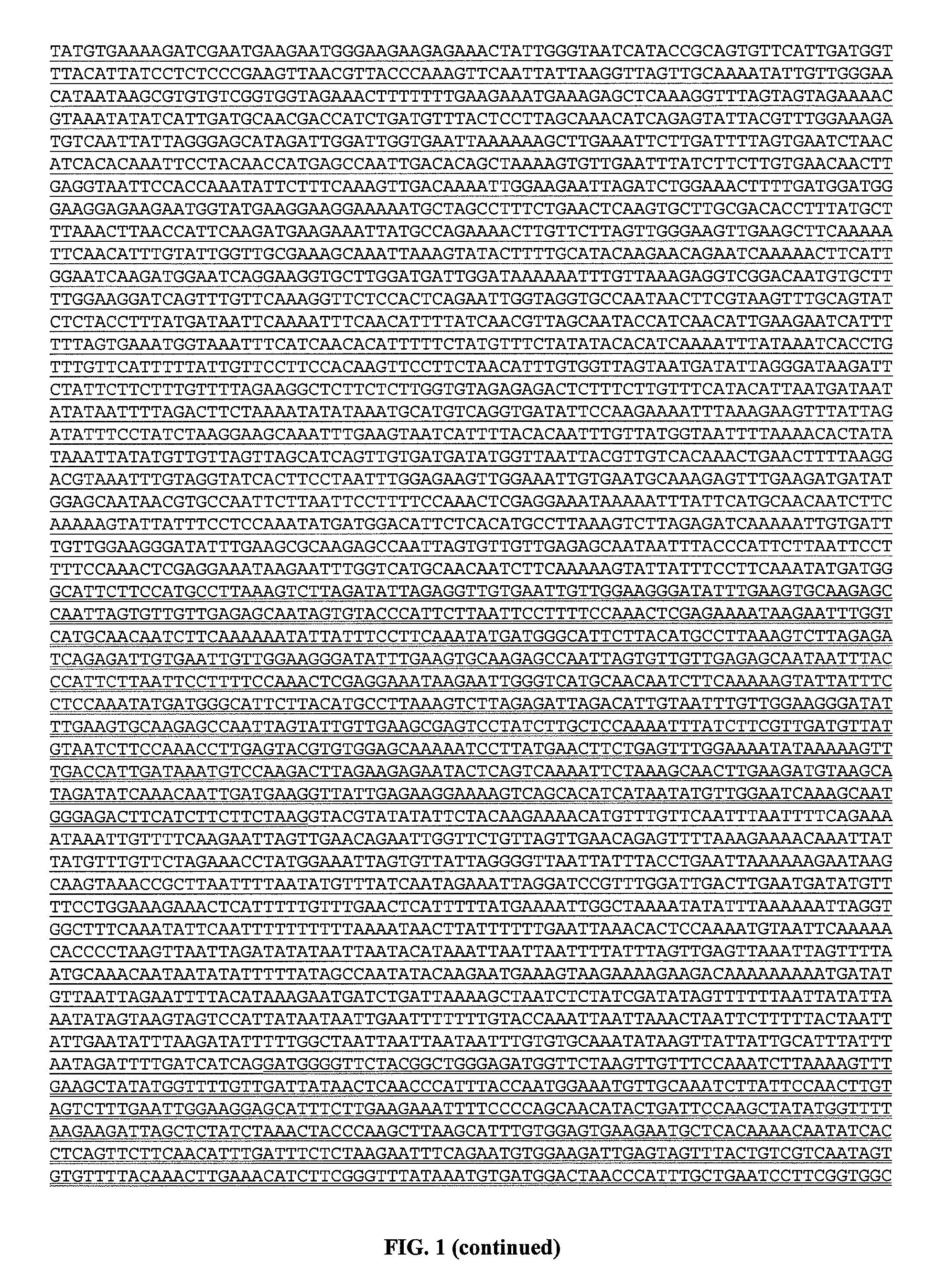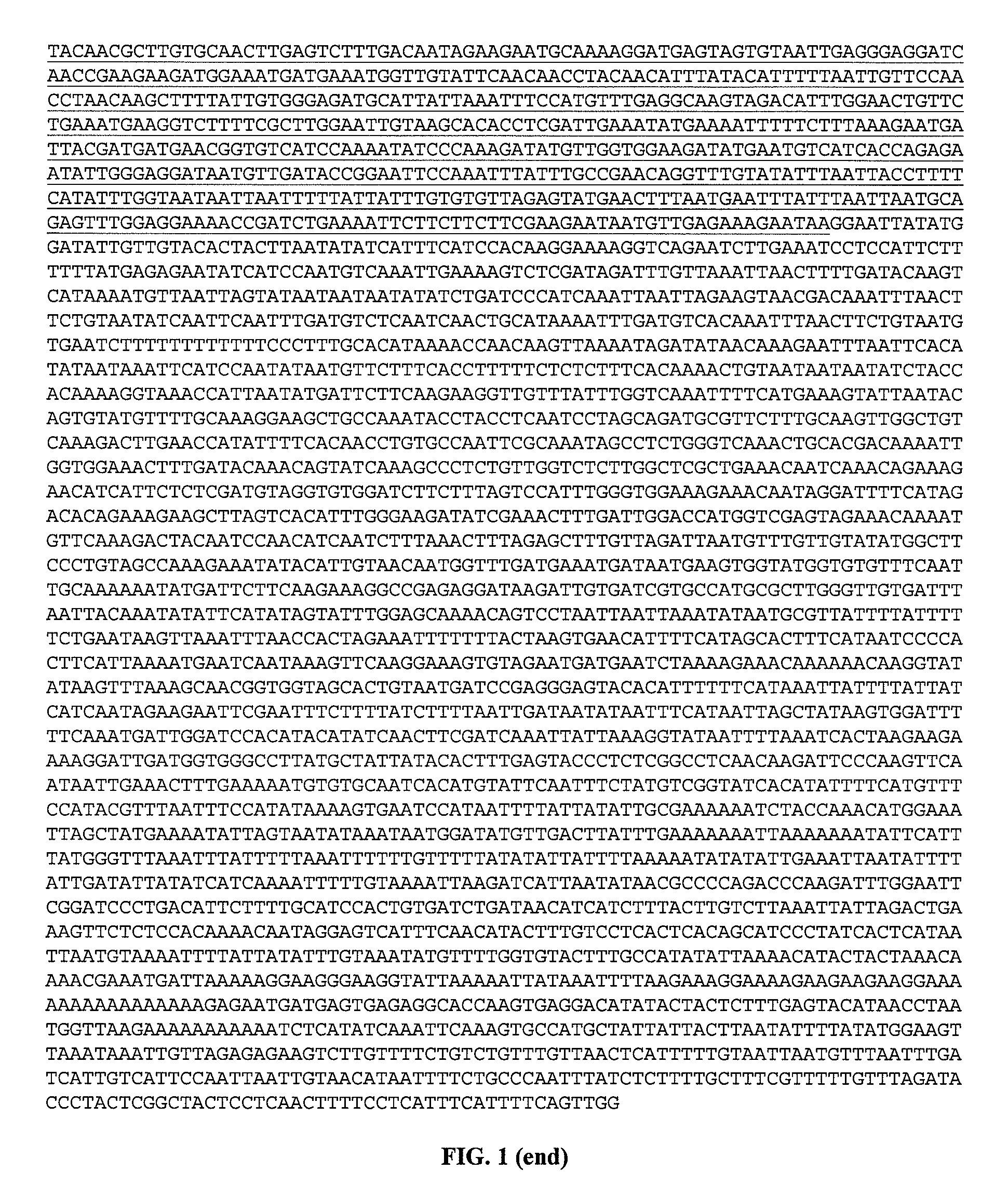Gene resistant to Aphis gossypii
a technology of aphids and resistant varieties, applied in the field of new means for combating insect pests, can solve the problems of reducing the photosynthetic capacity of plants, aphids diverting plant resources, and a rapid total infestation of crops in the open field and a fortiori in the greenhouse, and achieve the effect of facilitating the identification of resistant varieties
- Summary
- Abstract
- Description
- Claims
- Application Information
AI Technical Summary
Benefits of technology
Problems solved by technology
Method used
Image
Examples
example 1
Identification of the Vat Gene by Means of a Genetic Approach
Creation of the BAC Library
[0080]A BAC library of genomic DNA from melon (variety PI 161375 resistant to Aphis gossypii and to viral transmission by this aphid) representing approximately 29 genome equivalents was constructed. The first part of the BAC library contains 66048 clones (DNA digested with BamHI, HindIII) and the second part contains 56448 clones (DNA digested with EcoRI).
Screening of the BAC Library and Choice of the BAC Clone Carrying the Vat Locus
[0081]In order to identify the clone carrying the Vat gene, the library was screened using markers flanking the Vat locus. Several BAC clones covering the Vat locus were identified and organized. Novel markers were generated from these BAC clones. The BAC clone 3.18.9 carrying a 170 kb insertion comprising the Vat locus was chosen in order to identify the Vat gene, and sequenced. This clone comprises the markers L273 and L246 that frame the Vat locus. Ten recombinant...
example 2
Subcloning and Verification of the Sequence of the Vat Gene
[0110]The Vat gene was subcloned into the vector pGEM®3Zf+ (Promega). To do this, the BAC clone 3-18-9 was digested with the MscI restriction enzyme. Each fragment thus generated was ligated into the vector pGEM®3Zf+ (Promega) and then screened with the markers flanking the Vat gene or inside this gene.
[0111]A 18185 bp clone containing the Vat gene was identified (clone C7.1). Sequencing of the ends of the C7.1 clone, enzymatic restrictions, and sequencing of the Vat gene with the oligonucleotides in table 1 made it possible to verify that this was indeed the Vat gene. The sequence of a 11097 bp portion of this clone is represented in FIG. 1, and also in the attached sequence listing (SEQ ID No.: 1).
example 3
Obtaining the cDNA of the Vat Gene
[0112]The cDNA was obtained using the Marathon™ cDNA clone kit (Clontech). This cDNA is represented in the attached sequence listing under the number SEQ ID No.: 2.
[0113]The Vat gene contains 4 exons and 3 introns:
[0114]The first exon contains 2367 bp and extends from base 1 of the ATG initiation codon (corresponding to position 2344 according to SEQ ID No.: 1) to base 2367 (corresponding to position 4710 according to SEQ ID No.: 1).
[0115]The first intron extends from base 2368 to base 2921 (4711 to 5264 according to SEQ ID No.: 1).
[0116]The second exon extends from base 2922 to base 4055 (5265 to 6398 according to SEQ ID No.: 1).
[0117]The second intron extends from base 4056 to base 4876 (6399 to 7219 according to SEQ ID No.: 1).
[0118]The third exon extends from base 4877 to base 5734 (7220 to 8077 according to SEQ ID No.: 1).
[0119]The third intron extends from base 5735 to base 5833 (8078 to 8176 according to SEQ ID No.: 1).
[0120]The fourth exon e...
PUM
| Property | Measurement | Unit |
|---|---|---|
| Fraction | aaaaa | aaaaa |
| Fraction | aaaaa | aaaaa |
| Fraction | aaaaa | aaaaa |
Abstract
Description
Claims
Application Information
 Login to View More
Login to View More - R&D
- Intellectual Property
- Life Sciences
- Materials
- Tech Scout
- Unparalleled Data Quality
- Higher Quality Content
- 60% Fewer Hallucinations
Browse by: Latest US Patents, China's latest patents, Technical Efficacy Thesaurus, Application Domain, Technology Topic, Popular Technical Reports.
© 2025 PatSnap. All rights reserved.Legal|Privacy policy|Modern Slavery Act Transparency Statement|Sitemap|About US| Contact US: help@patsnap.com



